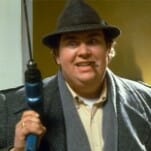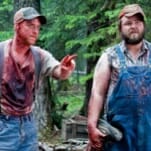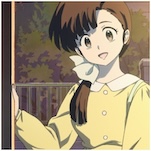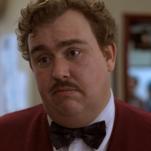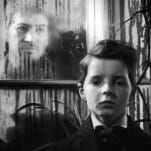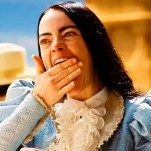Patrick McHale & Jim Campbell Climb Over the Garden Wall One Last Time in Four-Issue Comic Miniseries
Despite lasting short of 115 minutes, Patrick McHale’s Over the Garden Wall miniseries for Cartoon Network scales epic ambitions that transcend its runtime. The 10-episode story follows step brothers Greg, a frog-loving adolescent whose non-sequiturs rival Mitch Hedberg’s, and Wirt, a neurotic teenager who records poetry and clarinet cassettes. The pair inexplicably finds itself marching through a folk-fantasy wonderland with the singular goal to find home. While that description may sound familiar—a clear design choice by its authors—the context shifts magnificently from episode to episode, pivoting from genres at a breakneck pace without ever losing a singular vision.
Debut episode “The Old Grist Mill” channels the Brothers Grimm’s fatalistic doom in the tale of a manic woodsman (Christopher Lloyd) who warns of an ominous beast, while the brothers battle a dog who transforms into a feral monster after ingesting black turtles (a recurring, unexplained sight throughout the series). Other episodes revel in the glow of Silly Symphony-era musicals, 1800s folk and John Hughes rom-com sincerity. And it all works together beautifully. Brave, bizarre and intoxicating, McHale offers the same element of surprise that marks his run as creative director/writer on Adventure Time and his quirky mystery novella, Bags.
Now, McHale and original storyboard artist Jim Campbell shift media for a final exploration of what lies Over the Garden Wall. Following a comic special that coincided with the show last November, KaBOOM! is releasing four standalone tales, the first of which is out today. Paste chatted on the phone with McHale about the emerging legacy of his show, how the comics medium affects his storytelling and the addictive music behind it all. (That’s a rock fact.)![]()
Paste: This comic is set between the third and fourth episodes of the cartoon. This is also a divide between one of the most light-hearted episodes, “Schooltown Follies,” and when things get a little more dark and adult, in “Songs of the Dark Lantern.” This first issue is definitely more whimsical and humorous, as was the previous one shot special with the wayward soldiers and land schooners. What’s drawing you to explore the more light-hearted side of Over the Garden Wall?
Patrick McHale: This comic is set between episodes three and four, but the second comic is between episodes four and five and the third episode is between episodes five and six. And the fourth comic is about the Woodsman and his daughter. It does get a little closer to the darker second half of the series as it goes. It’s not really cohesive—it’s just additional things that fit in with the rest of the show.
That said, it does veer more towards the lighter side of things, mostly because it works better for comics. When doing some stuff, I have a sense of how to build the mood or make something creepy. In comics, I really don’t know how to do that. Some people can, but maybe because I’m new to comics, it’s hard for me to think that way without music. If there’s no music, it’s more fun to go with the lighter side of things and make it more about the visuals and jokes.

Over the Garden Wall #1 Interior Art by Jim Campbell
Paste: Were the stories in the comics created initially for the cartoon series? I know you’d initially planned for 18 episodes…
McHale: Well, back when I pitched Tome of the Unknown right out of college, back then I had big plans for my future. I said if this ever got picked up, I’d do three seasons. When I actually started working in the industry, and then it all developed into actually making this miniseries, I was told to brainstorm and lay it out ideally how I’d want it as a finite story, and then we would discuss it.
I wrote 18 premises—it felt nice. I said that fills out everything in detail. And then for the amount of time we had to finish it, and our deadline and all that stuff, well we could only do 10. So I had to chop it down a little bit.
Paste: So were stories you’re going to be telling in the comic thought out for the cartoon series, or are they recent creations?
McHale: A lot of ideas from those additional episodes were mashed together or re-used in different ways for what actually became the series. So it wasn’t like they were these things that were already written that I could just use; it was more like there were these two characters that were supposed to be in an episode that never ended up in an episode, and now I have to write a story for them.
Paste: Greg’s non sequiturs and punchlines work out beautifully for the comic format, especially the food magician bit. Is it easier to write some characters in this form than in cartoon scripts?
McHale: Not necessarily. Writing comics is still weird for me because I’m not drawing it, whereas with animation we usually write an outline and then go right to storyboard. So it’s like you’re writing it and drawing it at the same time. With comics, I’m writing a script and giving it to [illustrator] Jim [Campbell] to do the art. It’s sort of a disconnect. I get a lot more wordy…I mean the show is already wordy enough, and then the comics are already more wordy. I’m just sitting there with words in front of me. So with some of the wordplay stuff, I have a little more time to play around, because that’s the only color that I have to work with.
-

-

-

-

-

-

-

-

-

-

-

-

-

-

-

-

-

-

-

-

-

-

-

-

-

-

-

-

-

-

-

-

-

-

-

-

-

-

-

-



































